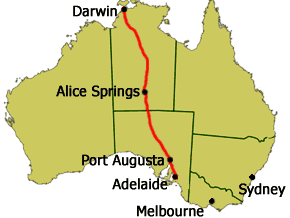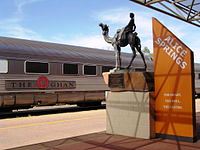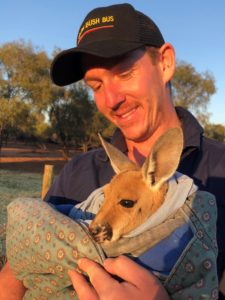» posted on Monday, July 25th, 2022 by Linda Lou Burton
Alice’s Wonderland
Originally Published July 25, 2020 by Linda Lou Burton posting about Alice Springs, Australia from Little Rock, Arkansas – I won a spelling bee in 5th grade with the word “aborigine.” I didn’t know the meaning, so Miss  Hudson had me look it up. That’s when I decided I’d visit Australia. So I am going to Alice Springs, and I am going to Uluru. I catch a Qantas ride this morning (on my NDI RTW); two hours to cover the 952 miles from Adelaide to the very center of the continent. I’m booked tonight at the AS Hilton with a view of the MacDonnell Mountain Range just out my window. The plan: get there in time for lunch. Winter is the best time to visit the Red Center; mornings and evenings are cool; days are sunny and warm.
Hudson had me look it up. That’s when I decided I’d visit Australia. So I am going to Alice Springs, and I am going to Uluru. I catch a Qantas ride this morning (on my NDI RTW); two hours to cover the 952 miles from Adelaide to the very center of the continent. I’m booked tonight at the AS Hilton with a view of the MacDonnell Mountain Range just out my window. The plan: get there in time for lunch. Winter is the best time to visit the Red Center; mornings and evenings are cool; days are sunny and warm.
The Tourism Australia website tells me this is what I will find.
- A true Aussie outback town in the heart of Australia’s Red Centre
- A sweeping horizon, burnt red dirt, and rugged mountain ranges
- A deeply spiritual and passionate Aboriginal community
- A stunning arts scene and fun and quirky festivals
- A sanctuary for orphaned kangaroos
https://www.australia.com/en-us/places/alice-springs-and-surrounds.html
A True Aussie Town & How It Grew
 Alice Springs is Australia’s geographic center, right between Adelaide and Darwin. The Red Center is an arid environment – annual rainfall 11 inches – consisting of several deserts. It’s known as Mparntwe to its original inhabitants, the Arrernte, who have lived in the Central Australian desert for tens of thousands of years.
Alice Springs is Australia’s geographic center, right between Adelaide and Darwin. The Red Center is an arid environment – annual rainfall 11 inches – consisting of several deserts. It’s known as Mparntwe to its original inhabitants, the Arrernte, who have lived in the Central Australian desert for tens of thousands of years.
European exploration began when John Stuart led an expedition through Central Australia in the early 1860s. Ten years later a white settlement was started with the construction of a repeater station on the Australian Overland Telegraph Line (OTL), which linked Adelaide to Darwin and Great Britain. This opened the interior for permanent settlement. The Alice Springs Telegraph Station was built near a waterhole and named Alice Springs after the wife of the Superintendent of Telegraphs, Charles Todd. It was after gold was discovered in 1887 that significant European settlement occurred; it was 1929 when the train line to Alice was built that the town’s European population began to grow. Aboriginal Centralians outnumbered  European Centralians until the mid-1930s.
European Centralians until the mid-1930s.
Camel trains were the original British-Australian transportation in the outback; operated by immigrants from then-British India (present-day Pakistan). Cameleers moved to Alice Springs in 1929 when the railway reached the town; they transported goods from the rail head to settlements to the north. The 1,849-mile Adelaide–Darwin railway was completed in 2004 when the Alice Springs-Darwin line opened. It is used by The Ghan passenger train and freight trains operated by One Rail Australia.
Who Lives There Now
 About 26,534 people live in the Alice Springs Urban Area. Aboriginal and Torres Strait Islander people made up 18% of the population. Aboriginal residents live in the suburbs, on special purpose leases or town camps, or further out at Amoonguna to the south and on small family outstation communities on Aboriginal lands in surrounding areas.
About 26,534 people live in the Alice Springs Urban Area. Aboriginal and Torres Strait Islander people made up 18% of the population. Aboriginal residents live in the suburbs, on special purpose leases or town camps, or further out at Amoonguna to the south and on small family outstation communities on Aboriginal lands in surrounding areas.
Americans have lived in Alice Springs since the establishment of the US Air Force Detachment 421 in 1954, as part of a joint American–Australian project called the Joint Geological and Geographical Research Station. Currently 2,000 residents of the Alice Springs district hold American citizenship. Several small immigrant communities have found a home in Alice Springs, including Vietnamese, Chinese, Thai, Sudanese and Indian ethnic groups.
Alice Springs has a large itinerant population composed of foreign and Australian tourists, Aboriginal Australians visiting from nearby communities, and Australian or international workers on short-term contracts working in stations, mines, healthcare and law enforcement.
The Terrain
 Arrernte country is rich with mountain ranges, waterholes, and gorges. The region consists of dry scrubby grassland and the MacDonnell Ranges which contain a number of hiking trails and swimming holes. The 139-mile Larapinta Trail follows the West MacDonnell Ranges and is considered among the world’s great walking experiences. The Simpson Desert southeast of Alice Springs is one of Australia’s great wilderness areas containing giant red sand dunes and interesting rock formations.
Arrernte country is rich with mountain ranges, waterholes, and gorges. The region consists of dry scrubby grassland and the MacDonnell Ranges which contain a number of hiking trails and swimming holes. The 139-mile Larapinta Trail follows the West MacDonnell Ranges and is considered among the world’s great walking experiences. The Simpson Desert southeast of Alice Springs is one of Australia’s great wilderness areas containing giant red sand dunes and interesting rock formations.
The Modern Town
The modern town of Alice Springs has European and Aboriginal influences. The Todd Mall hosts a number of Aboriginal art galleries. Alice Springs has many historic buildings, including the Overland Telegraph Station and Adelaide House, a beautiful stone building that was Central Australia’s first hospital; now a museum, it was built in 1926 by John Flynn, founder of the world’s first flying doctor service. A dispatch centre for the Royal Flying Doctor Service of Australia operates here. https://www.rfdsalicesprings.com.au/
The town is an important tourist hub and service center with several large hotels, a convention center, and a range of attractions, restaurants, and tour services. Alice Springs has nineteen public and private schools; School of the Air delivers education to students in remote areas.
The Stunning Arts Scene & Quirky Festivals
 Alice Springs has a big reputation for Aboriginal art. Many diverse art galleries showcase one of the oldest living traditions in the world; contemporary art works tell traditional stories; superb dot paintings and watercolours by some of Australia’s most successful and prominent Aboriginal artists, including Barbara Weir, Minnie Pwerle and Albert Namatjira. A range of galleries line Todd Mall; the Araluen Arts Center is the hub of the visual arts scene. Read about the collections, the work done there, the public art, and the sacred sites, such as the hills that represent the dreaming of the Two Sisters, and the sacred 300-year-old corkwood tree. https://araluenartscentre.nt.gov.au/your-visit
Alice Springs has a big reputation for Aboriginal art. Many diverse art galleries showcase one of the oldest living traditions in the world; contemporary art works tell traditional stories; superb dot paintings and watercolours by some of Australia’s most successful and prominent Aboriginal artists, including Barbara Weir, Minnie Pwerle and Albert Namatjira. A range of galleries line Todd Mall; the Araluen Arts Center is the hub of the visual arts scene. Read about the collections, the work done there, the public art, and the sacred sites, such as the hills that represent the dreaming of the Two Sisters, and the sacred 300-year-old corkwood tree. https://araluenartscentre.nt.gov.au/your-visit
Two quirky festivals of note: the Camel Cup and the Henley-On-Todd Regatta. Yes, July’s Camel Cup is just that, a day of really fun camel racing. And the Henley-On-Todd Regatta is a “boat” race in the dry sandy bed of the Todd River. It is the only “dry” regatta in the world, and yes, back in 1993 it was “called on account of rain.”
Orphaned Kangaroos
 A Kangaroo Sanctuary with guided sunset tours through a 188-acre wildlife reserve; meet and feed rescued baby and adult kangaroos. Animals Come First is the motto; founder Brolga Barns says “Our mission is to educate and encourage people to rescue and care for kangaroos and other wildlife.” Kangaroo Dundee, a BBC/Nat Geo Series, is filmed here; shown in over 90 countries and now in its third series. Donations welcome. https://kangaroosanctuary.com/
A Kangaroo Sanctuary with guided sunset tours through a 188-acre wildlife reserve; meet and feed rescued baby and adult kangaroos. Animals Come First is the motto; founder Brolga Barns says “Our mission is to educate and encourage people to rescue and care for kangaroos and other wildlife.” Kangaroo Dundee, a BBC/Nat Geo Series, is filmed here; shown in over 90 countries and now in its third series. Donations welcome. https://kangaroosanctuary.com/
I’m glad I was in that spelling bee, back in 5th grade. You never know how far a single word can take you.
